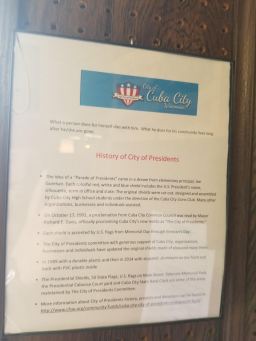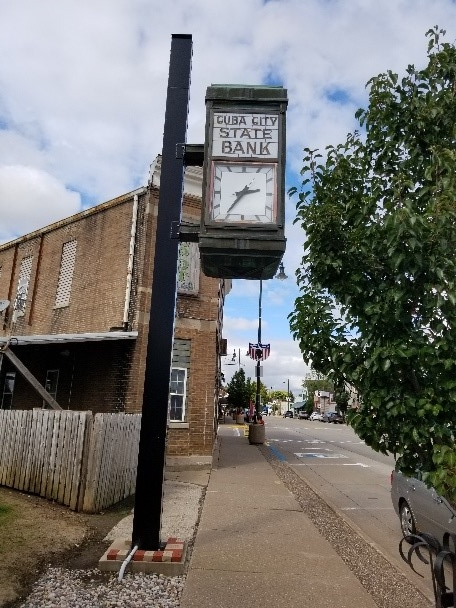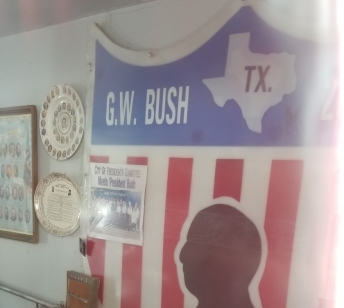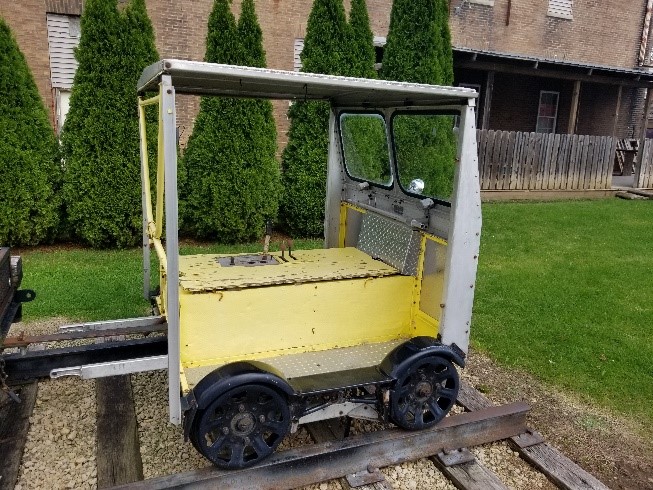Experience the grandeur and prestige of Cuba City’s heritage

In the deep north of America’s bread basket lies a tiny town of about 2000 people called Cuba City, Wisconsin. The town is nestled snugly between the bustling and collegiate Platteville metropolitan area (pop. 11,000) and a cluster of even smaller towns like Hazel Green, WI (pop. 1256) to the south and Dickeyville, WI (pop. 1060) to the west. The town is fundamentally a strip of road lined with businesses which are surrounded on both sides by a grid of single story houses that stretches for a half mile outward in all directions.

Along this strip of Highway 80, one immediately notices the signs with silhouettes of U.S. Presidents: all of the U.S. Presidents. One may also soon see the focal point of this, the main strip of Cuba City’s main street: a tourist attraction called the “Presidential Courtyard,” a monument to the city’s nickname, “The City of Presidents.” Cuba City is a time capsule of small town America filled with relics from the Cold War age of patriotism.

Questions about the naming of Cuba City are so common that many shops have hung signs explaining how the city got its name. Every store, retailer, and restaurant has these signs which are written by the city, perhaps to help visitors get more confused.

Around town there is a theory regarding the evolution of the town’s name: the town was originally “Yuba City” but since there was already a “Yuba” in Richland county, “Cuba” was chosen as an alternative.
How did “Cuba City” then become the “City of Presidents”? Let’s start there and work our way backwards to the presidential signs.
The official title was chosen in 1993 when the city’s common council changed the slogan from the “Parade of Presidents” by popular vote. But the patriotic naming scheme started in 1975 when the village was preparing to celebrate the United States Bicentennial Anniversary. The titular parade referred to plywood sigils featuring those silhouettes of every American president referred to earlier, which were and are still hung on every lamp-post along Cuba City’s main street. The sigils have since been replaced with durable weather proof plastic, and joined by the “Presidential Courtyard” near the center of the strip, one I’ll talk more about in a moment.

All of those signs seem like a lot of work for the 1976 Bicentennial Celebration, especially for a town of 2000 people. One theory about why the town leaned into such heavy participation in the bicentennial was that they wanted to ward off any suspected affiliation with communist Cuba. At that time in global politics, Cuba was a bastion of socialist thought and was the source of a much anxiety in the American consciousness (and had been so since the Bay of Pigs in the early 1960s.). Having this unpatriotic tie to Cuba would not have been good for the city’s tourism so they may have doubled-down and made a very American tourist attraction to counteract this association.
Is this true? One retired history professor commented that she had also heard this speculation, as had the editor of this blog. But neither could link it to documentary evidence, so a speculation it remains. In any case, since the original presidential signs in the 1970s, the idea has taken on a life of its own.
Since then, the Presidential Courtyard has been built upon a patch of grass along Main Street where the sigils ended. But of course more presidents have been added to the parade since the late seventies so the courtyard is now about two-thirds down the street.
The best and easiest way to experience the displays is to drive into town and park along the main street near the edge of town where you can casually walk the stretch of road at your own pace. There are benches to rest on along the way and plenty of shops and bars to sit or get distracted in. If you’re worried about parking on a busy street you can park in the residential neighborhoods for the same effect (remember to note what street you’re on so you can find your way back later). For the travelers short on time there is also a free and public parking lot at the Presidential Courtyard itself.
By the time you’ve soaked in the sights, sounds, and smells of the flowers you’ll find yourself back at the “Presidential Courtyard.” This courtyard was assembled from scratch in 2006 as an addition to the Parade of Presidents and it contains a bright red train caboose, several potted plants, informative signs, and a stray cat with a tuxedo pattern on its fur.

As you enter the courtyard from the front you will notice a large refurbished clock hanging above you like it has hung over Cuba City since its construction. Inside the clock is a time capsule made by the Cuba City high school and is scheduled to be opened on the 50th anniversary of the courtyard’s construction in 2056.
The train caboose is a refurbished and well maintained train car. Along with the portrait of Ulysses S. Grant, one sees a variety of informational signs. Next to the train on the same track is a utility cart with a display of railroad tools. Opposite the track is a gazebo optimized for family picnics and a few benches, all of which have more signs for visitors to learn from.
The caboose acts a mini-museum of presidential history. Also, one of the presidential sigils hangs here in the corner instead of on the street: the one with a silhouette of George W. Bush, the only U.S. president to actually visit Cuba City. President Bush signed it when he visited in October of 2004.
A leading figure in Cuba City, Joe Goeman, explained that it was “one of the biggest things to happen to Cuba City [when] the president came to visit. Of course, that didn’t happen by itself. We had people write to the presidents for several years until finally it happened.”

The rest of the caboose has displays of memorabilia from presidential campaigns and other Americana. The caboose is open to the public on Saturdays between Labor Day and Memorial Day and also on the third Wednesday of every month or by appointment.
Behind the caboose is a smaller car called a “Speeder Car” which has a tray of tools hitched to the back. The speeder car adds depth to the train display by showing the variety of tools needed to build and maintain a train network and implying the hard work and skill needed for America to have such powerful industry. Opposite the speeder car is a milk trolley with a trio of vintage milk canisters on one side. The milk trolley has plenty of room for visitors to climb up on and take photos as a family. The milk trolley is included as part of Wisconsin’s history of milk processing.

This location is a fun place to visit firstly as a relic of 1970’s patriotism, secondly as a testament to Cuba City’s talent of maintaining public works projects, thirdly as a unique slice of Midwestern culture, and lastly as a unique place to discover by oneself or as a group of domestic explorers.
